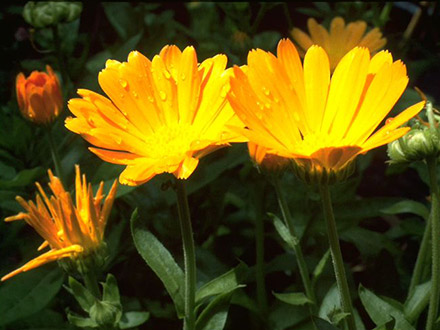Botanical name
Calendula officinalis L.
Family
Asteraceae
Common name
Calendula, Common marigold, Pot marigold, Scotch marigold, Mary’s gold
Information about the plant
Calendula is an ancient cultivated and ornamental plant, presumably planted in cottage gardens and cemeteries in the 12th century in Germany. Today, it can often be found growing wild on rubble heaps, along roadsides, fences, and in vineyards. It is native to Central, Eastern and Southern Europe. The genus name Calendula is derived from the Latin "calendae" (= the first day of the month) and roughly translates to "little calendar". The species epithet officinalis suggests that it is an old medicinal plant, as "officina" refers to the salesroom of a pharmacy, and "officinalis" means commonly used in the pharmacy. The German name "Ringelblume" refers to the ring-shaped curved fruits of the plant, while the English name "marigold" refers to the flowers’ colors.
Calendula grows 30 to 50 cm tall with a richly branched upper part and with downy, hairy stems. On them are alternate, oblong, hairy leaves. The large flower heads are very striking, with a diameter of 5 cm to 7 cm, consisting of a circle of orange-coloured ray florets up to 2 cm long and a cushion of orange funnel-shaped florets on the inside. In gardens, it is often found as “filled” calendula with several circles of florets. The flower is surrounded by an involucre. The flowering time is from June to September.
Medicinally used parts of plants (herbal drug)
The flowers (Calendulae flos) are used. The receptacle must be separated so that the drug consists mainly of the ray florets and a few disc florets. The commercially available drug comes mainly from imports from Poland, Hungary, and Egypt.
Constituents of the herbal drug
Calendula flowers contain flavonoids, triterpene alcohols, triterpene saponins, carotenoids, polysaccharides, and an essential oil.
Quality of the drug
The quality of calendula flowers (Calendulae flos) is specified in the European Pharmacopoeia (Ph. Eur.). The quality of the following drug preparations is specified in the German Pharmaceutical Codex (DAC):
- Calendula fluid extract (Calendulae extractum fluidum)
- Calendula tincture (Calendulae tinctura)
Medical applications
Recognised medical use
The HMPC has classified calendula flowers as a traditional herbal medicinal product (see "Traditional use").
ESCOP: for the treatment of minor inflammations of the skin and mucosa; supports the healing of minor wounds.
Traditional use
The HMPC has classified calendula flowers as a traditional herbal medicinal product (§ 39a AMG). Based upon long-standing use, calendula flowers can be used externally to treat minor inflammations of the skin (such as sunburn) and as an aid in healing of minor wounds. They can also be used to treat minor mouth or throat inflammation.
Herbal drug preparations in finished dosage forms
- Calendula flowers for the preparation of an infusion for external use
- Alcoholic extracts (also tincture) for the preparation of creams, ointments or mouthwashes
- Extracts with vegetable oils in ointments
Dosage
Prepared drugs: see patient information leaflet.
Tea: dab the skin area several times a day with a freshly prepared tea or use warm for mouthwash and gargle.
Preparation of a tea
Pour 150 ml of hot water over 1-2g of calendula flowers, let it stand for 5-10 minutes, and strain.
Notes
People who already have an existing allergy to Asteraceae should avoid calendula flowers and their preparations.
No safety studies are available on the use of calendula flowers during pregnancy and lactation or for use in children under 6 years old.
Side effects
Rarely, skin irritation.
Interactions
None known.
References
Herbal drug monographs
HMPC (2018), ESCOP (2019), WHO (Vol. 2, NIS)
Further literature
Commentary on the European Pharmacopoeia (Calendula flowers, no. 1297)


